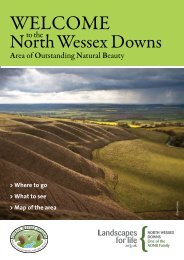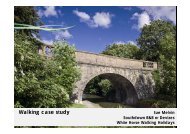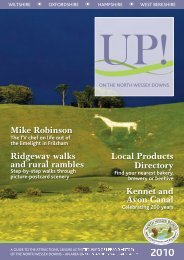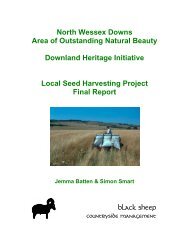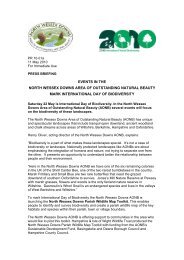UP! - North Wessex Downs Area of Outstanding Natural Beauty
UP! - North Wessex Downs Area of Outstanding Natural Beauty
UP! - North Wessex Downs Area of Outstanding Natural Beauty
Create successful ePaper yourself
Turn your PDF publications into a flip-book with our unique Google optimized e-Paper software.
SILBURYCLOSER TO BEING SOLVEDSilbury Hill, close to Avebury in Wiltshire, has long been a powerful but mute challenge toarchaeologists. Recent conservation work on the prehistoric site, has now drawn to a close,giving archaeologists a great deal to think about.People <strong>of</strong> the Late Neolithic period must have had a very good reasonfor building successive mounds <strong>of</strong> chalk to a height <strong>of</strong> some 40m andcreating what we now call Silbury Hill. Unfortunately they left no cluesthat would help today’s archaeologists discover what that reason was.However, late last year English Heritage archaeologists investigating theSilbury Hill site made a discovery that might at least shed light on howsubsequent generations used the place. The iconic shape that we recognisetoday, they say, may not have been how the hill looked when it was first built.They believe the summit may have changed from a domed shape when it wasconstructed 4,400 years ago into the current ‘flat top’ hundreds <strong>of</strong> years later,in Saxon or Norman times.A series <strong>of</strong> medieval postholes have been discovered (one <strong>of</strong> which was verylarge), on top <strong>of</strong> the hill, possibly indicating that a huge military building hadbeen there during the Saxon or Norman periods. They have also discoveredtwo iron arrowheads which suggest the building had a military/defensivefunction, such as a defended lookout post or signal station. They now alsobelieve that the summit <strong>of</strong> Silbury Hill was also significantly modified andflattened during this period.ATTEMPTS TO FIND OUT WHYWeighing in at a calculated half a million tons, Silbury Hill is the largest prehistoricartificial mound in Europe; it was built around 2,300BC and appears tobe closely associated with nearby long barrow tombs and the stone circle atAvebury, but what was its exact function? Attempts to find out have beenmade by at least three men.The first was the Duke <strong>of</strong> <strong>North</strong>umberland. He marched to the top <strong>of</strong> thehill in 1776 and dug a vertical shaft by which he explored the centre <strong>of</strong> the hillbefore marching down again. A horizontal tunnel was dug in 1849 by the RevDean John Merewether and another was dug by Pr<strong>of</strong> Richard Atkinson, in1968-69. None <strong>of</strong> the three extracted anything <strong>of</strong> great significance and none<strong>of</strong> them did a very good job in refilling the holes they had made – whichbrings us to a burst <strong>of</strong> activity in 2007.Eight years ago a hole about 14m deep fell in at the mound’s summit.Remotely operated cameras revealed that the Duke <strong>of</strong> <strong>North</strong>umberland’sattempts at restoration had proved inadequate and that the two tunnels werealso collapsing. At that time English Heritage engaged Skanska CivilEngineering to carrying out a temporary filling <strong>of</strong> polystyrene blocks beneath aprotective capping <strong>of</strong> chalk. During the summer <strong>of</strong> 2007 Skanska engineersnot only removed the temporary filling from the cap and replaced it withcompacted chalk, they also re-entered the Hill via the tunnel dug by Pr<strong>of</strong>essorAtkinson in 1968, and removed the old packing used by the Pr<strong>of</strong>essor and histeam when they left the Hill. This enabled English Heritage archaeologists toexamine deep inside the Hill and take samples from the different stages <strong>of</strong>building for analysis. The engineers then repacked the Atkinson Tunnel withcompacted chalk to stabilise the Hill for the long term. Silbury Hill is now asclose to being as good as new – or old – as possible.While the engineers were doing their bit, the investigative archaeologiststried to add to their existing knowledge <strong>of</strong> the mound by further archaeologicalrecording. For instance, Pr<strong>of</strong> Richard Atkinson’s dig suggested that the Neolithicbuilders first created a circular mound <strong>of</strong> turf and river gravel.They then enlarged it with alternating layers <strong>of</strong> chalk and soil. Finallythey topped everything <strong>of</strong>f with a massive third layer <strong>of</strong> chalk which wasgradually covered by wind-borne soils and grass seeds to produce the SilburyHill as we see it today. Core samples from earlier bores into the body <strong>of</strong> themound have provided archaeologists with the means <strong>of</strong> checking whetherthe Pr<strong>of</strong>essor was right.Archaeologists now have a pretty good idea what sort <strong>of</strong> landscapeoriginally surrounded the mound. Evidence gleaned from pollen and seedsamples, insect remains and animal bone extracted from the soils underlyingthe mound show that chalk grassland was already established in the vicinity <strong>of</strong>Silbury before the mound was created.FEW TREESChalk grassland rich in herbs indicates managed grazing and the lack <strong>of</strong> insectremains <strong>of</strong> a sort that were dependent on woodland encourages the thoughtthat there were relatively few trees about. The presence <strong>of</strong> dung beetleremains is strong evidence <strong>of</strong> fairly heavy stocking rates <strong>of</strong> livestock. Thus apicture emerges – a landscape not vastly different from today’s;predominantly grass for grazing animals and cultivated crops. Trees were beingcleared and although there were no fields as such, the landscape was beingchanged to one that met the needs <strong>of</strong> a sedentary agricultural community.By the time this article is being read the archaeologists will be back in their<strong>of</strong>fices poring over the new findings that their high-tech equipment has madepossible. Radiocarbon dating shows that building Silbury Hill began some timebetween 2445 and 2190BC. Given luck, the investigators will have found neworganic material that will provide a more precise date. Perhaps they will havea stab at telling us how many people were involved.“Weighing in at a calculated halfa million tons, Silbury Hill is thelargest prehistoric artificial moundin Europe”Currently it is thought (carbon dating again) that Silbury Hill took eitherless than 115 years to complete, or between140 and 435 years. The finding <strong>of</strong>new organic material might enable the archaeologists to establish thischronology more accurately.Silbury Hill is as secretive now as it was when the Duke <strong>of</strong> <strong>North</strong>umberlandfirst clapped eyes on it. The notion that it might be a burial mound has largelybeen discounted. It could have been constructed for purposes <strong>of</strong> worship orfor ceremonial occasions. The fact that it is part <strong>of</strong> the Avebury World HeritageSite which includes Windmill Hill and Avebury Henge, the West Kennet LongBarrow and the West Kennet Stone Avenue is surely significant.As the English Heritage website puts it: “The people who built the lateNeolithic Silbury and Avebury were more distant in time from the originalbuilders <strong>of</strong> the early Neolithic Windmill Hill and the West Kennet Long Barrowthan we are from the Normans and their castles.”That raises an interestingthought. Did the need to feed a vast labour force over a period spanning manygenerations oblige the prehistoric organisers to develop their agriculturalexpertise to a level unique at that time?Right: Silbury Hill – built around 2,300 BC with great insight into problems <strong>of</strong> soilengineering. The sides are thought to be carefully stepped and the interior containsradial chalk walls for added stability. The hill was built to last, and it has.6 <strong>UP</strong>! ON THE NORTH WESSEX DOWNS



